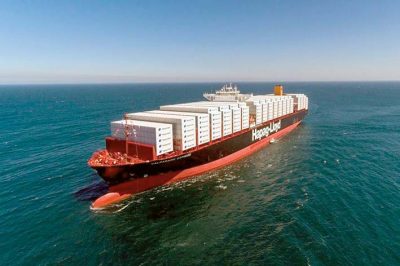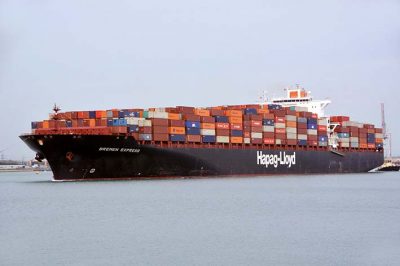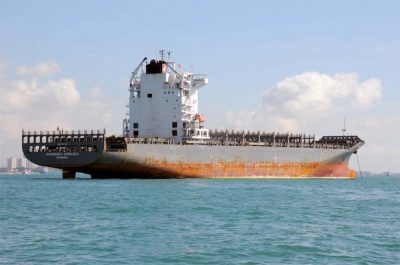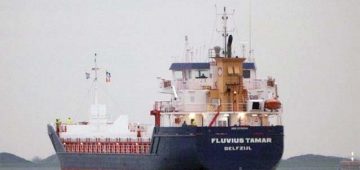APL, part of CMA CGM, launched a New Zealand Express II (NZ2) service as from late December. The new weekly service, linking New Zealand and North Asian ports, complements the company’s New Zealand Express (NZE) service. With the launch of the NZ2 service, APL said it will offer a network of six Oceania services that connect Asia with Australia and New Zealand. The NZ2 Service will call at the ports of Shanghai, Ningbo, Chiwan (China), Kaohsiung (Taiwan), Brisbane (Australia), Auckland, Port Chalmers, Lyttelton, Napier, Tauranga (New Zealand), Hong Kong (Hong Kong) and Keelung (Taiwan). The first sailing of the new service departed from Shanghai on 29th December 2016.
CMA CGM dropped the US Lines (USL) brand used on the company’s transpacific and North America-Oceania services towards the end of 2016. APL has taken over the USL transpacific services while another CMA CGM subsidiary, ANL, is taking on USL’s North America-Oceania services. California-based US Lines was founded in May 2003 and CMA CGM bought it in 2007. CMA CGM’s European Caribbean Service moved to London Gateway in the New Year, with the first call on 6th January following enhancements to the route’s rotation.
Dedicated to reefer transport, CMA CGM says the service will provide one of the shortest transit times on the market between Central America and North Europe. It also enables the UK to connect with the whole of the Caribbean region through CMA CGM’s strategic hub in Kingston, Jamaica.
Conbulk Shipping SA of Greece has disposed of its two Handysize containerships, the 16,800gt/1996 built Cresco and the 16,252gt/1997 built Sonoma. Both were built by Polish shipbuilder Stocznia Szczecin Nowa. Conbulk’s remaining fleet is comprises of nine containerships, six Handysize vessels and three Sub-Panamax vessels.
COSCO Container Lines Co. Ltd. has changed its company name to COSCO Shipping Lines Co., Ltd. The process began on 18th November 2016 with the change becoming official as of 1st January 2017.
Danaos, a Greek container ship owner, suffered an $8.4 million net loss in the third quarter of 2016 from a $42.1 million profit a year earlier thanks to the collapse of Hanjin Shipping and the associated loss of charter revenue. Three vessels with capacities of 10,100 TEU and five 3,400 TEU capacity ships on long-term fixed rate time charters were returned by Hanjin, reducing operating revenue by $24.8 million. Danaos had logged a $15.8 million write-off due to outstanding hire charter debt on the eight Hanjin-chartered ships as of 30th June. Hanjin’s creditors are now jockeying in court to get whatever payments they can from what was formerly the world’s seventhlargest container liner.
Euroseas has acquired the 16,211gt/1998 built and 1,645 TEU feeder containership RT Dagr (above) from Tennenbaum Capital Partners, a Euroseas shareholder, for around 900,000 shares of the company’s common stock. The vessel was scheduled to be delivered before the end of 2016. Including the newly acquired vessel, Euroseas has a fleet of 14 vessels made up of six dry bulk vessels and eight feeder containerships.
Hanjin Shipping’s 4,275 TEU containership quartet were sold to South Korean company Korea Marine Transport Co. (KMTC) for a price of $22.4 million. The 260m long and 32m beam 2008-built Panamaxes, which were sold through a bank sale, are the 40,487gt Hanjin Durban, Hanjin Norfolk, Hanjin Piraeus and Hanjin Rio de Janeiro and fetched $5.6 million each. The sale came only days after three 13,000 TEU Hanjin containerships were sold at an auction in Rotterdam for a total of $392 million. The 2012 and 2013 built/141,754gt Hanjin Europe, Hanjin Africa and Hanjin Harmony were reportedly sold on behalf of the German HSH Nordbank. Another Hanjin ship, the 141,754gt/2013 built Hanjin Gold, was expected to be auctioned off by a Rotterdam court in January 2017. The 65,184gt/1998 built and 5,302 TEU capacity Hanjin Rome, which was arrested on 29th August 2016, was put up for auction in Singapore at the end of 2016 with bids closing on 12th January.
Hapag-Lloyd held a naming ceremony on 7th December for the 118,945gt/2016 built Valparaiso Express (above), the first of five new vessels of a new 10,500 TEU capacity class. Mrs. Rozio Gonzalez, the wife of Mr. Andronico Luksic, Chairman of the Board of the Quinenco Group, performed the ceremony at the Terminal Pacifico Sur (TPS) in the port of Valparaiso, where the new ship will call regularly in future. The Quinenco Group is the largest shareholder of CSAV, one of the three controlling shareholders of the Hapag-Lloyd. The first vessel in the new Valparaiso Express class will sail in the revised Europe-South America West Coast service of Hapag-Lloyd in which four of the five newbuildings are replacing older Panamax ships, while a second Panamax size loop (SW2) and two slot charter agreements (EW1 and EW2) in the same trade lane will be terminated. As a result, Hapag- Lloyd can deploy more efficient vessels between North Europe and South America West Coast without adding significant capacity to the market. The new SW is a premium service in this trade covering the major markets in North Europe, the Caribbean and West Coast South America.
An undisclosed number of containers fell from the 93,750gt/2008 built and 8,750 TEU capacity containership Bremen Express (above) for reasons that could not be determined at the time. The vessel experienced severe rolling during a repair stop in the Atlantic over the Christmas period whilst enroute from Norfolk, USA. The 336m long ship was located some 1,400 nautical miles west of Europe when the incident occurred. Hapag-Lloyd said that the ship would call at the Port of Tangier Med, Morocco, in the Mediterranean in order to be inspected before passing through the Suez Canal on her journey to Asia.
Hyundai Merchant Marine (HMM), still nursing its wounds after failing to gain complete membership of 2M, has announced plans to order up to 10 ships at South Korean yards in 2017. HMM has five small and medium sized containerships planned for redelivery and scrap in the second half of 2017 and five containerships will be needed as replacements plus three to five VLCCs, which will also be ordered in 2017. The new containerships will be deployed on intra-Asia trades. HMM’s forecast to secure a 5% global market share of all container business by 2021 has been looked upon as unrealistic by industry experts. It currently has a 2.2% share and to reach its goal HMM would need to expand current vessel capacity of 455,000 TEU to more than 1.1m TEU over the next four years, an increase of 650,000 TEU at a time when the liner trade is suffering from overcapacity and low rates. One source put HMM’s target into perspective by comparing the additional capacity required to reach a 5% market share as equivalent to acquiring the entire operated fleet of Hanjin Shipping prior to that carrier’s collapse in late August. HMM’s transpacific market share has risen from 4.4% to 6.6% since Hanjin’s demise but whether or not that is sustainable remains to be seen.
Kawasaki Kisen Kaisha (K Line) launched a new China Saigon Indonesia (CSI) container service on 26th December from Qingdao. The service has direct port coverage from China to Ho Chi Minh, Vietnam and Indonesia. A total of four containerships, each with a capacity of 2,500 TEUs, will be deployed on the new containership service, the port rotation for which is Qingdao (China)-Shanghai-Ningbo-Ho Chi Minh (Vietnam)-Jakarta (Indonesia)-Semarang- Xiamen (China)-Qingdao. The company has also submitted a civil lawsuit against APL Logistics in the Tokyo District Court relating to rumours it was planning to file for bankruptcy. In the lawsuit, K Line said it was seeking compensation for damages in light of some of APL Logistics’ employees spreading false information to clients about the above. K Line’s reputation had reportedly been significantly impacted by the rumours, causing booking cancellations and suspensions by clients. The incident took place on or around 20th/21st September 2016 when a small number of APL Logistics Group employees conveyed opinions to several customers that touched on the potential financial position or viability of K Line.
Korea Line Corporation (KLC), which signed a deal to purchase troubled Hanjin Shipping’s Asia to US assets in November 2016, has made some changes to the terms and conditions of the agreement. The bulk carrier operator, which is a subsidiary of construction conglomerate SM Group, has excluded the full acquisition of seven Hanjin subsidiaries in countries including the USA, China and Vietnam, Hong Kong, Singapore, Malaysia and India from the agreement with permission from the Seoul Central District Court, which is handling Hanjin’s rehabilitation proceedings. Instead, KLC will just take over Hanjin’s Hong Kong subsidiary. With this the bulk carrier operator will purchase Hanjin’s Asia-US network, client management and operational data, logistics management systems and relevant workforce as well as the Hong Kong unit for a lesser sum of Won27.5bn ($22.9m).

Maersk Line, MSC and Hyundai Merchant Marine (HMM) announced a new strategic co-operation on 11th December 2016. The co-operation is a combination of slot exchanges and slot purchases between the three parties, as well as Maersk Line and MSC taking over a number of charters and operations of vessels currently chartered to HMM. The co-operation is outside the scope of MSC and Maersk Line’s 2M vessel sharing agreement but will provide HMM access to the 2M network. So, HMM has not been successful in gaining full membership of 2M. For Maersk Line the co-operation will provide new opportunities, not least in the Transpacific trade where 2M gets access to strong HMM products. The agreement is scheduled to begin in April 2017 subject to regulatory approval. The initial term of the co-operation is three years with an option to extend and covers key East-West trades. The parties expected to disclose more information about network changes and schedules during early 2017.
Clients of 2M have not reacted well to the prospect of their cargoes being loaded on to HMM ships when 2M partners take over charter and operation of a number of the South Korean carrier’s ships with HMM being a slot charterer on Asia-Europe and Asia-US east coast routes. Both operators have been obliged to give assurances to customers that cargo will only be loaded onto HMM Asia-US west coast ships if they agree. Under the 2M+H Strategic Co-operation agreement as it will be known, HMM will continue to operate its own Asia-US west coast services with reports suggesting that these consist of four ships that are operated within the G6 alliance, and five vessels that are operated independently by HMM on its HNS (Hyundai New Start) loop that it launched in September after the collapse of compatriot Hanjin.
Maersk Line has sent eight of its Panamax containerships to be recycled in shipbreaking yards in India and China. Deals for the vessels were struck in early December. In India, two vessels will be recycled by Shree Ram, and two more will go to Y.S. Investments. The remaining four vessels will be recycled at Jiangyin Xiagang Changjiang Ship Recycling in China, Estimated transfer dates of the vessels to the ship recycling yards are between mid-December 2016 and mid-March 2017. The ships are former Sea-land vessels, namely the 49,985gt/1995 built Sea-Land Comet and Sea Land Mercury, the 49,985gt/1996 built Sea Land Racer and Sea Land Meteor and the 49,985gt/1997 built Sea-Land Lightning, Sea-Land Charger, Sea- Land Intrepid and Sea Land Eagle.
Orient Overseas Container Line (OOCL) increasingly became the subject of speculation during January that it was up for sale. Subsequently the share price of its parent firm soared more than 20% since the start of the year. OOCL has denied any truth in the rumours but time will of course tell. That said, industry experts have tipped CMA CGM as the potential buyer.
The Panama Canal’s extended form had been operational less than six months when the waterway welcomed its 500th transit of a Neopanamax ship on 14th December 2016. The 90,389gt/2006 built YM Unity, an 8,204 TEU containership owned by Greek-based shipping company Navios Maritime Partners, performed the 500th transit. Built by South Korean shipbuilder Hyundai Heavy Industries in 2006, the 335.7m long and 42.8m beam ship was en route from Asia and called at Colon Container Terminal in Panama before heading to US ports.
Pacific International Lines (PIL) of Singapore placed an order as 2016 came to a close with Chinese yard Taizhou Kouan for one firm 600 TEU ship plus an option for a sistership. The first ship is due for delivery in 2018. PIL, owned by the Teo family, focuses on the intra-Asia trades and is the 14th largest liner in the world.
Rickmers Maritime of Singapore confirmed in mid-December that it had sold a 7-year-old containership for scrap in order to pay down bank debt, becoming at the time, the youngest containership ever scrapped.
A newer 7-year old Panamax Containership (above), the 40,541gt/2010 built Hammonia Grenada, has since gone for scrap for around $5.5 million. The 4,250 TEU vessel was one of two identical ships delivered to its German owners, Hammonia Reederei GmbH, on 15th January 2010.
The vessels were built at China’s Jiangsu New Yangzijiang. Both were initially on a 5-year charter by Compania Sud Americana de Vaproes S.A. (CSAV). More recently the Hammonia Grenada was on charter by Maersk Line lasting until November 2016.
Seaspan Corporation of Hong Kong has purchased four Panamax containerships from the bankrupt South Korean container carrier Hanjin Shipping through a bank sale. The vessels were sold by a consortium of banks led by the Export Import Bank of Korea and Germany’s HSH Nordbank.
The four 4,275 TEU capacity ships are the 40,487gt/2008 built Hanjin Kingston, 40,466gt/2009 built Hanjin Gdynia, 40,487gt/2009 built Hanjin Atlanta and 40,487gt/2009 built Hanjin Monaco. The vessels were built by South Korea’s Samsung Heavy Industries between 2008 and 2009 and each sold for $5.6 million.
Thorco Shipping (Holland), who’s main base is in Copenhagen, reached an agreement with Dutch shipping companies Navigia and Feederlines in December to join forces in respect of technical ship management. The new company will manage a total of 65 vessels and will represent four brands including Thorco Projects, Navigia, Feederlines and Peak. Earlier in 2016, Feederlines was separated from the former shareholder, Reederei Hartmann, and is now 100% owned by Jan van der Laan, while Navigia is controlled by Jan van Breden and Eric Bos.
Both companies merged their management activities earlier in 2016. Navigia/Feederlines received confirmation at the beginning of December 2016 that the technical management of six Abis B-type 3,800 dwt open top vessels had been awarded to them by new owners, Peak Norway, another operator benefitting from the demise of a shipping operator, namely Abis Shipping. Thorco Shipping had itself benefitted tonnage- wise from the demise of the Flinter Group.
ZIM announced in December that it will offer a number of new and upgraded services effective from the beginning of 2017 as it looks to reaffirm its market position amid increased competition from the soon-to-be launched new liner alliances. With The Alliance and the Ocean Alliance set to join 2M to form the three major container line consortia operating the east-west trades, ZIM has responded with a revised network of its own whilst it remains free of the operating groups.
The changes will affect the transpacific, Asia-Mediterranean and transatlantic offerings from the start of April 2017, coinciding with the inception of the two new alliances. On the transpacific trade, a new loop will be launched between Asia and the Pacific Northwest.

The service via the Panama Canal from Asia to the US east coast will be upgraded, while, as previously announced, the Zim Seven Stars service will resume full activity after the winter programme.








Comments
Sorry, comments are closed for this item